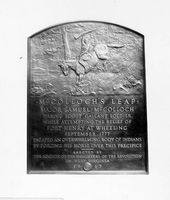 | Back to e-WV
| Back to e-WV
 The West Virginia Encyclopedia
The West Virginia Encyclopedia
 | Back to e-WV
| Back to e-WV
 The West Virginia Encyclopedia
The West Virginia Encyclopedia

Samuel McColloch, one of four brothers who emigrated from the South Branch of the Potomac to Wheeling in 1770, is remembered as the courageous horseman who leaped with his horse from Wheeling Hill, 300 feet to the bottom, to escape Indians during a Revolutionary War skirmish.
Early on the morning of September 1, 1777, Indians appeared at the crest of Wheeling Hill. Believing that the enemy force consisted of only a few warriors, the militia of Fort Henry pursued, under the command of Capt. Samuel Mason. After following the Indian trail down to Wheeling Creek, they were suddenly ambushed by a large Indian war party and most of the militia were killed. A few survivors hastened to the neighboring forts with the news of the assault upon Fort Henry.
One of those forts was Van Meter’s, located on Short Creek several miles to the north, and commanded by Maj. Samuel McColloch. He hastily assembled two or three men and rode to the relief of Fort Henry, but upon his approach, he was cut off by a small party of warriors. Turning his horse, and closely pursued by the Indians, he managed to gain the crest of Wheeling Hill, only to be cut off once more. McColloch spurred his horse to the edge of the precipice and leaped to the waters of Wheeling Creek far below.
Surprisingly, McColloch survived the leap with nothing more than a few scratches and bruises, and his horse survived as well. McColloch returned to Van Meter’s and gathered together a force of about 40 militia. On the following day they rode to the relief of Fort Henry, only to find that the Indians had lifted their siege a few hours earlier.
McColloch later lost his left arm in a hunting accident and was killed in another Indian ambush in 1782. Today a granite monument on U.S. 40 marks the site of the heroic leap of Samuel McColloch.
Written by William Hintzen
Newton, J. H. History of the Pan-Handle. Wheeling: Caldwell, 1879.